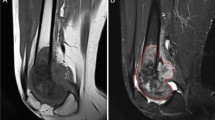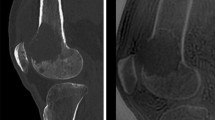Abstract
Objective
Assessment of the extent of tumours using magnetic resonance imaging (MRI) is the basis for bone resection in limb-salvage surgery. We aimed to compare the accuracy of T1-weighted MRI and STIR sequences in measuring the extent of proximal femoral tumours, using the macroscopic specimens as the gold standard for comparison.
Materials and methods
We compared single coronal T1-weighted with STIR sequences in 34 proximal femoral tumours, using bivalved resected macroscopic tumours for comparison. After randomisation, four observers measured longitudinal osseous tumour extent using MRI and specimen photographs on two separate occasions, 3 weeks apart.
Results
There were 25 metastatic tumours, 8 chondrosarcomas and 1 myeloma. Eight patients presented with pathological fractures. The Pearson’s correlation coefficient for comparison of T1 with macroscopic tumours was 0.91 (95 % confidence interval [CI]: 0.83 to 0.96) for all observers and 0.90 (95 % CI: 0.81 to 0.95) for STIR images. This difference was not statistically significant, and T1 and STIR sequence measurements had similar precision and accuracy. Bland–Altman plots showed T1-weighted imaging to be unbiased, whereas STIR sequences were biased and had systematic error. Moreover, STIR measurements overestimated tumour size by 6.4 mm (95 % CI: −26.9 to 39.7 mm) and 2 patients were outliers. T1 measurements were closer to the macroscopic measurements with a mean difference of 1.3 mm (95 % CI: −28.9 mm to 31.5 mm), with 3 patients falling outside of this. The variance was greater for STIR measurements. This difference between T1 and STIR measurements was statistically significant (p = 0.000003). The intra-observer reliability between separate measurements for MRI and specimen photographs achieved interclass correlation coefficients of 0.97, 0.96 and 0.95 (T1, STIR and macroscopic tumour respectively). T1 had greater interobserver correlation than for STIR and macroscopic tumour measurements (0.88 vs 0.85 and 0.85 respectively). These differences in interclass correlation were not statistically significant.
Conclusion
This study has shown T1-weighted MRI sequences to be unbiased compared with STIR sequences at determining intra-osseous tumour extent. STIR overestimates the length of bone tumours. T1 is therefore preferred for pre-operative planning for the resection of bone tumours.






Similar content being viewed by others
References
Simon MA, Aschliman MA, Thomas N, Mankin HJ. Limb-salvage treatment versus amputation for osteosarcoma of the distal end of the femur. J Bone Joint Surg Am. 1986;68-A:1331–7.
Cheng EY, Thompson Jr RC. New developments in the staging and imaging of soft-tissue sarcomas. Instr Course Lect. 2000;49:443–51.
Sanders TG, Parsons III TW. Radiographic imaging of musculoskeletal neoplasia. Cancer Control. 2001;8:221–31.
Gillespy T, Manfrini M, Ruggieri P, Spanier SS, Pettersson H, Springfield DS. Staging of intraosseous extent of osteosarcoma: correlation of preoperative CT and MR imaging with pathologic macroslides. Radiology. 1988;167:765–7.
Meyer MS, Spanier SS, Moser M, Scarborough MT. Evaluating marrow margins for resection of osteosarcoma. A modern approach. Clin Orthop Relat Res. 1999;363:170–5.
Van Trommel MF, Kroon HM, Bloem JL, Hogendoorn PC, Taminiau AH. MR imaging based strategies in limb salvage surgery for osteosarcoma of the distal femur. Skeletal Radiol. 1997;26:636–41.
Sundaram M, McGuire MH, Herbold DR, Wolverson MK, Heiberg E. Magnetic resonance imaging in planning limb-salvage surgery for primary malignant tumors of bone. J Bone Joint Surg Am. 1986;68-A:809–19.
O’Flanagan SJ, Stack JP, McGee HM, Dervan P, Hurson B. Imaging of intramedullary tumour spread in osteosarcoma: a comparison of techniques. J Bone Joint Surg (Br). 1991;73-B:998–1001.
Hao YK, Zhang YK, Yang ZP, Li X, Yang Q, Li JM. The accuracy of magnetic resonance imaging in determining the osteotomy plane in osteosarcoma. Orthopedics. 2008;31:544.
Han G, Wang Y, Bi WZ, et al. Magnetic resonance imaging is appropriate for determining the osteotomy plane for appendicular osteosarcoma after neoadjuvant chemotherapy. Med Oncol. 2012;29:1347–53.
Dwyer AJ, Frank JA, Sank VJ, et al. Short-TI inversion-recovery pulse sequence: analysis and initial experience in cancer imaging. Radiology. 1988;168:827–36.
Golfieri R, Baddeley H, Pringle JS, Souhami R. The role of the STIR sequence in magnetic resonance imaging examination of bone tumours. Br J Radiol. 1990;63:251–6.
Shuman WP, Patten RM, Baron RL, Liddell RM, Conrad EU, Richardson ML. Comparison of STIR and spin-echo MR imaging at 1ST in 45 suspected extremity tumors: lesion conspicuity and extent. Radiology. 1991;179:247–52.
True Random Number Service. URL http://www.random.org/. Accessed 11 March 2013.
R: a language and environment for statistical computing. R Foundation for Statistical Computing, Vienna, Austria. URL http://www.R-project.org/ Accessed 17 November 2013.
Fellows I. Deducer: a data analysis GUI for R. J Stat Softw 2012;49:1–15.
Baloch KG, Grimer RJ, Carter SR, Tillman RM. Radical surgery for the solitary bony metastasis from renal-cell carcinoma. J Bone Joint Surg. 2000;82-B:62–7.
Fiorenza F, Abudu A, Grimer RJ, et al. Risk factors for survival and local control in chondrosarcoma of bone. J Bone Joint Surg (Br). 2002;84:93–9.
Singletary SE, Walsh G, Vauthey JN, et al. A role for curative surgery in the treatment of selected patients with metastatic breast carcinoma. Oncologist. 2003;8:241–51.
Avedian RS, Haydon RC, Peabody TD. Multiplanar osteotomy with limited wide margins: a tissue preserving surgical technique for high-grade bone sarcomas. Clin Orthop Relat Res. 2010;468:2754–64.
Bielack SS, Kempf-Bielack B, Delling G, et al. Prognostic factors in high-grade osteosarcoma of the extremities or trunk: an analysis of 1,702 patients treated on neoadjuvant cooperative osteosarcoma study group protocols. J Clin Oncol. 2002;20:776–90.
Kawaguchi N, Ahmed AR, Matsumoto S, Manabe J, Matsushita Y. The concept of curative margin in surgery for bone and soft tissue sarcoma. Clin Orthop. 2004;419:165–72.
Wong KC, Kumta SM, Antonio GE, Tse LF. Image fusion for computer-assisted bone tumour surgery. Clin Orthop Relat Res. 2008;466:2533–41.
Cho HS, Oh JH, Han I, Kim HS. Joint-preserving limb salvage surgery under navigation guidance. J Surg Oncol. 2009;100:227–32.
Khan F, Pearle A, Lightcap C, Boland PJ, Healey JH. Haptic robot-assisted surgery improves accuracy of wide resection of bone tumours: a pilot study. Clin Orthop Relat Res. 2013;471:851–9.
Jeys L, Matharu GS, Nandra RS, Grimer RJ. Can computer navigation-assisted surgery reduce the risk of an intralesional margin and reduce the rate of local recurrance in patients with a tumour of the pelvis or sacrum? Bone Joint J. 2013;95-B:1417–24.
Abed YY, Beltrami G, Campanacci DA, et al. Biological reconstruction after resection of bone tumours around the knee. Long term follow-up. J Bone Joint Surg. 2009;91-B:1366–72.
Onikul E, Fletcher BD, Parham DM, Chen G. Accuracy of MR imaging for estimating intraosseous extent of osteosarcoma. AJR Am J Roentgenol. 1996;167:1211–5.
Wallack ST, Wisner ER, Werner JA, et al. Accuracy of magnetic resonance imaging for estimating intramedullary osteosarcoma extent in pre-operative planning of canine limb-salvage procedures. Vet Radiol Ultrasound. 2002;43:432–41.
Golfieri R, Baddeley H, Pringle JS, Leung AW, Greco A, Souhami R. MRI in primary bone tumors: therapeutic implications. Eur J Radiol. 1991;12:201–7.
Acknowledgments
The authors wish to thank Mr N. Harness, Mr M. Pritchard, Mrs P. Evans and the Histopathology Department for taking the photographs of the pathological specimens.
Conflict of interest
The authors declare that they have no conflict of interest. No benefits in any form have been received or will be received from a commercial party related directly or indirectly to the subject of this article.
Author information
Authors and Affiliations
Corresponding author
Rights and permissions
About this article
Cite this article
Ahmad, S., Stevenson, J., Mangham, C. et al. Accuracy of magnetic resonance imaging in planning the osseous resection margins of bony tumours in the proximal femur: based on coronal T1-weighted versus STIR images. Skeletal Radiol 43, 1679–1686 (2014). https://doi.org/10.1007/s00256-014-1979-2
Received:
Revised:
Accepted:
Published:
Issue Date:
DOI: https://doi.org/10.1007/s00256-014-1979-2




